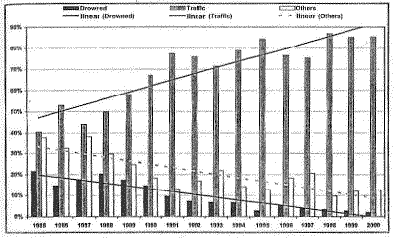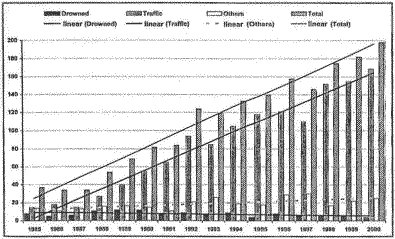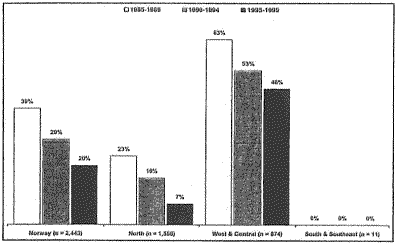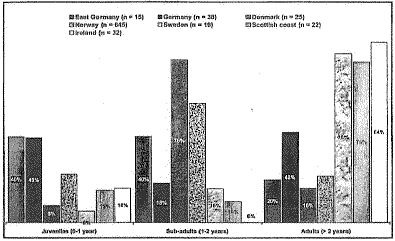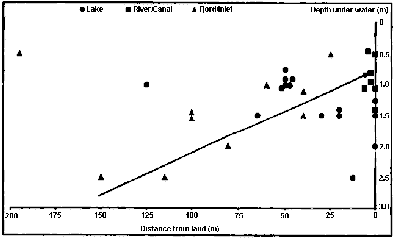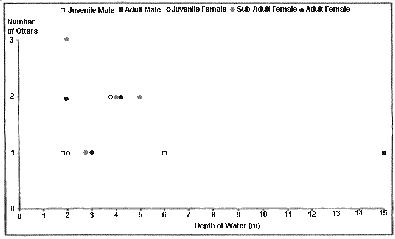 |
Last Update:
Thursday November 22, 2018
|
| [Home] |
|
Volume 19 Issue 1 Pages 1 - 61 (April 2002) Citation: Reuther, C. (2002) Otters and Fyke Nets - Some Aspects which Need Further Attention. IUCN Otter Spec. Group Bull. 19(1): 7- 20 Otters And Fyke Nets -Some Aspects Which Need Further Attention Claus Reuther Aktion Fischotterschutz e.V., OTTER-ZENTRUM, 29386 Hankensbüttel, Germany, e-mail: c.reuther@otterzentrum.de (Received 30 December 2001; accepted 24 May 2002)
INTRODUCTION Whilst preparing the third and completely revised edition of the brochure for fishermen on otters and fyke nets (REUTHER, 2001), first published by Aktion Fischotterschutz (German Association for Otter Conservation) in 1991 (RÖCHERT and REUTHER, 1991), some questions arose about this subject. This was due to the fact that several colleagues offered new and unpublished data. Whilst processing this data and in trying to prepare recommendations for fishermen, it became clear that there were some results which are inconsistent or founded on insufficient data to offer a background for adequate conservation recommendations. In the following article, therefore, some aspects will be highlighted to encourage otter conservationists and researchers in other countries to collect more data and to contribute to a more reliable database for conservation measures. ASPECTS WHICH NEED FURTHER ATTENTION Eurasian otters (Lutra lutra) are attracted by fishes caught in fyke nets, lobster creels or other fishing gear, and they are sometimes drowned by trying to get access to these fish. Numerous publications describe this problem and the attempts to avoid this kind of loss (JEFFERIES, 1989, 1993; JEFFERIES et al, 1984; JEFFERIES et al, 1989; MADSEN, 1986, 1991; REUTHER, 2001; RÖCHERT and REUTHER, 1991). However, some aspects of this conservation problem need further attention. The reliability of the database In many countries or regions, data on otters found dead are collected systematically and this information is an important source for gaining knowledge on threats and for various estimations of population status. However, this data only represents part of the problem, as it only gives us information on mortalities in otters that are found, rather than information on all the otters that die in the wild, i.e. many otters will die and never be found by humans. This has the potential to bias the data set in favour of road kills and fishery deaths, possibly leading to misconceptions about the major threats to otters. Another problem is caused by the fact that, in many cases, the cause of death cannot be definitely identified. Nevertheless, in many published studies, the proportion of unidentified causes of death is astonishingly low. When comparing this data with the high proportion of otters, which died in captivity resulting from unidentified or unclear causes in post mortem examinations I have seen, this is really surprising. Alternatively, some losses caused by trauma, such as road casualties, drowning, or shooting, are clearly identifiable, though in some cases it is not clear as to what extent illnesses or other impairments of the animals were also involved. A special problem is related to the speculation that fishermen do not report all otters found dead in fishing gear. It is difficult, if not impossible to get evidence or specific numbers for this assumption. However, in discussions with fishermen, the argument has arisen several times that 'the reporting of dead otters might result in more restrictions for fishermen and therefore such accidents should be concealed'. Comparison of percentages of otters killed in fyke nets or fishing gear There are numerous publications giving the number or the percentage of otters killed in fyke nets or other fishing gear as a proportion of all otters found dead in a specific area and period. An overview is given in Table 1.
Such comparisons should be made with great care as they do not automatically reflect a real relationship. As is shown in Figure 1, the percentage of otters drowned in fyke nets in Germany over the period 1985-2000 seems to show a clear linear trend of decrease from 21.6% in 1985 to 2.0% in 2000. Looking only at the numbers of otters drowned in fyke nets, this decrease is much lower and the linear trend seems to be more or less stable (Figure 2). This is due to the fact that the total number of otters, which were found dead, increased markedly over this period (from 37 in 1985 to 198 in 2000), the majority of the 1,769 otters represented in this statistic being killed on roads (n = 1,344). Accordingly, the number of traffic casualties show a clear linear trend of increase, whilst the other causes of death referring to the total number remain more or less stable.
Attention must also be paid to regional differences, as can be shown by the example of Norway (Figure 3). The proportion of otters killed in fishing gear for the whole country over the period 1995-1999 seems to be only half that found ten years earlier in the period 1985-1989. After splitting the data into three regions with different intensity of fyke net use, clear regional differences become obvious. In West and Central Norway, the decrease in the proportion of otters killed in fishing gear over 1985-1989 was less than one third of that found over 1995-1999. However, in North Norway the proportion of otters drowned in fishing gear decreased by nearly two thirds between these two periods.
Seasonally To date, there are only two publications available giving data on the seasonal distribution of the drowning of otters in fyke nets. They show some interesting differences (Figure 4). It appears that, in the former East Germany, such accidents occur all year round with the highest risk over the period September to November (STUBBE et al., 1993). The latter is also true in general for Denmark (MADSEN, 1991). Though this increasing risk seems to start one month earlier in this country and here the highest percentage is related to the month of May.
Age and sex of drowned otters A comparison of five publications (FAIRLEY, 1972; MADSEN, 1991; STUBBE, et al., 1993; TWELVES, 1983; UTHLEB et al., 1992) presenting data on the age of otters drowned in fishing gear, as well as the unpublished data of Thrine Heggberget for Norway and of Anna Roos for Sweden, produced some interesting differences (Figure 5). Whilst the majority of the otters drowned in Germany, Denmark and Norway were two years and younger, in Sweden, Ireland and on the Scottish coast, the majority of drowned otters were two years and older.
In the five publications mentioned above the sex of the otters was also reported. The data show the surprising fact that the sex-ratio of drowned males to females over all age classes varies from 1:0.25 in Germany, to 1:0.77 in Denmark, to 1:1 in Ireland and to 1:5.66 on the Scottish coast. Clear regional differences are also obvious for age classes. In Germany, more than 80% of the juveniles were male, whilst in Ireland, females are mainly affected. In Denmark and on the Scottish coast, however, the male-female-ratio was 1:1 for this age class. In Denmark, similar results were obtained for sub-adults as juveniles. In Germany, males dominated the sub-adult class, whilst all sub-adults found in lobster creels were females on the Scottish coast. Of adult otters drowned, the majority were male in Germany and Denmark, female on the Scottish coast, whilst the proportion of both sexes was nearly the same in Ireland. Dimension of guards JEFFERIES et al. (1984) recommended some maximum measurements for the openings of guards and fishing equipment designed to exclude otters. On the basis of the body dimensions of five females and four males (Table 2) they calculated the following openings to be sufficient:
The otter's body widens from the head to the neck and then to the shoulders and to the chest. The latter represents the largest dimension relevant for this topic. The otter's body is very flexible, allowing it to penetrate small openings in relation to their weight. In particular, the hindquarter and the forequarter cross sections can be reduced in size by manipulating the limbs. Whilst handling immobilised otters in the enclosures of the German Association for Otter Conservation, it was possible to take measurements of the body dimensions of 11 females and 13 males. Some individuals could also be measured at different ages and times of the year. All measurements were taken as circumferences at the neck and at the chest at their maxima just before the chest and just after the forelegs. From the circumferences the diameters were calculated assuming a circle. Because the chest is roughly elliptical in cross section, the greatest ('elliptical length') and the smallest ('elliptical breadth') diameters were calculated for the chest, assuming an egg-shaped elliptical cross section and using the formula of ROMANOFF and ROMANOFF (1949) for such ellipses, as previously done by JEFFERIES et al. (1984). For both, the neck and the chest, the measurements were taken as 'loose' circumferences, by running the measuring tape around the body without pressing it, and as 'narrow' circumferences, by pressing the tape as much as possible around the body. The dimensions recommended by JEFFERIES et al. (1984) should be sufficient for rigid rings and rigid square grids for the majority of otters (Table 3). A mean of 101.7mm for the 'narrow' diameter and 116.1mm as a mean 'narrow' elliptical length of the chest of females exceeded the maximum openings recommended for these two types of guards. However, for three of the 11 females and for one of the 13 males, the 'narrow' diameter of the chest was calculated as less than 95mm. The male was one year old and the females were 1-3 years old. In contrast, only one female with a calculated 'elliptical length' of 105.3mm came close to the recommended diameter opening for rigid square grids. All other otters exceeded this dimension. A higher risk for the animals seems to arise from the recommended circumference of 300mm for flexible nets. One third of the females and one male showed a 'narrow' circumference at the chest that was 300mm or less. These measurements might also provide ideas for the construction of different shaped guards. Tests with captive otters on land with a rigid circle grid guard (250mm diameter; 3mm stainless steel), divided into three vertical sections with a maximum width of 80mm, showed that otters could overcome this guard by pressing the two bars apart and by moving through the opening by turning the body in a vertical position (Reuther, unpubl. data). First tests under water indicate that this might also be possible for females and small males. This is not surprising as, regarding the calculated 'elliptical breadth' shown in Table 3, at least three females and one male showed measurements less than 80mm for this parameter. Placement of fyke nets Only two publications could be found where the position of the fishing gear (depth under water and/or distance from land) was correlated to the number, the sex or the age of drowned otters. The data of MADSEN (1991) for Denmark (Figure 7) indicates that the risk increases as the water the fyke net is located in becomes shallower and the closer it gets to land. However, there is no information provided as to how these data correspond with the range of water depth and distance from land for all fyke nets used in these areas. This is also true for the data on otters drowned in lobster creels on the Scottish coast published by TWELVES (1983). She found the majority of dead otters at a depth of 2-5 metres (Figure 8). Because of the low numbers for both samples, no correlation could be found between age and/or sex as to the placement of the fishing gear.
The indication that the deeper the traps are set the less likely mortality will occur is also supported by the observations of JEFFERIES et al. (1984). They reported that no otters were drowned in freshwaters of Scotland where the fyke nets were set at a depth of 4.5-54m, whereas large numbers of otters were killed in fyke nets set in very shallow freshwater lochs in the Hebrides. WINJGAARDEN and PEPPEL (1970) also report most damage to fyke nets caused by otters in the Netherlands was observed when these were set close to the bank and in water less than 1m deep. CONCLUSIONS AND RECOMMENDATIONS Traffic casualties represent the dominant majority of known losses of otters in most Western European countries at the moment. However, accidental drowning of otters in fishing gear is still a factor that needs attention, as well as to what extent this could easily be reduced through technical measures. One of the main problems as regards the development of adequate conservation measures is the low data-base and lack of knowledge of the circumstances that influence the risk of the drowning of otters in fishing gear. This involves a certain danger that conservation activities exceed the real necessities and that, because of this, the acceptance of conservation measures by fishermen will be reduced. To answer this, there is a need for an increase in trust and cooperation between conservationists and fishermen. Conservationists should make fishermen aware that their intention is to ensure the protection of otters whilst still ensuring an optimal fish harvest. To reach this target it is essential that fishermen contribute as much data as possible on the fishing techniques they use and on all accidental mortalities of otters in fishing gear. The apparent dramatic increase in the number of otters that are killed by traffic accidents introduces a danger that, in considering only the percentage of otters that are drowned in fishing gear, this problem will be underestimated. It would make more sense to relate the number of otters drowned to the number of fyke nets (or of other fishing gear) being used in a specific region. This would also reflect regional differences for the extent of the risk for otters on a more reliable basis. The problem is that, in many European countries, the authorities do not know these numbers. It would, however, be interesting to investigate and compare such correlations for different regions. More detailed data are also necessary for the different types of fishing gear and fishing techniques. It is not enough to try to interpret the differences in the seasonality, the sex, or the age classes of otters drowned shown above only on the basis of factors related to the biology of the otter. It is also necessary to take the different types of fishing gear and fishing techniques into account. Some examples of possible research topics follow: Are the differences in seasonality, as shown in Figure 4, caused by seasonal differences in the intensity of use of fyke nets? Why were mainly juvenile and sub-adult otters drowned in Germany, Denmark and Norway, but mainly adults in Sweden, Ireland and the Scottish coast? Is this correlated with different fishing techniques or equipment? Why do four times more males drown in Germany than in Scotland, and six times more females in Scotland when compared to Germany; and why is the sex ratio in Denmark and Ireland more or less 1:1? Is this caused by different territorial systems, by different foraging techniques of the sexes, or is this also influenced by different fishing techniques of the fishermen? Do the results of some studies, showing that otters are mainly drowned in fyke nets which are deposited in shallow water close to the bank, really express a higher risk or do they only reflect a common fishing technique whereby the majority of fyke nets are deposited there? There is no doubt that previous protection measures, e.g. stop-grids for eel fyke nets, were pioneering work and resulted in a remarkable contribution to the conservation of otters (MADSEN and SØGARD, 2001). It is also an important contribution to the acceptance of such protection measures by fishermen that they are tested as regards their influence on fishing efficiency, especially if such investigations are carried out by or in cooperation with fishing specialists (JEFFERIES et al., 1988; MADSEN, 1991; BERG, 1993; PEDERSEN and KNIGHTS, 1994; KOED and DIEPERINK, 1999). However, such protection measures are not accepted everywhere and the technical measures available to date are limited to fyke nets used to catch eels. One of the remaining open questions is how to avoid the drowning of otters in fishing gear, which is used to catch larger fish. To date, there have been a number of attempts to develop technical measures for this type of fyke net (MAERZ and MEYER, 1989; MUNR, 1999; REUTHER, 2001; TEUBNER et al., 1998). Technical protection measures, however, are only one way to reduce the number of losses of otters in fishing gear. There is also a need to ask whether a reduction in mortality could also be achieved by alterations to fishing techniques. As underlined before, this requires more data on the relationship between these techniques and the loss of otters. By establishing confidential relationships and cooperation with fishermen, which is an essential precondition to receive such data, the first step for a third way to the target is taken: an improvement in the acceptance of otter conservation by fishermen. I want to encourage all conservationists and scientists involved in otter conservation or fishery techniques to collect and to publish more data referring to the questions mentioned above. In particular, practical experience and test results will increase the efficiency of otter conservation. Because of the great variety of factors, which could influence such studies and their results (e.g. type of water body, depth and velocity of the water, type and size of fishing gear, where traps are set, and the species fished for) the establishment of international and inter-disciplinary cooperation could improve the efficiency of such an attempt to a great degree. ACKNOWLEDGEMENTS - 1 would like to thank the following persons and institutions who generously provided unpublished data forming the basis for most of the figures: Silke Hauer, Martin-Luther-Universität, Halle-Wittenberg; Thrine M. Heggberget, Norwegian Institute for Nature Research (NINA), Trondheim; Information System Otter Spuren (ISOS), Aktion Fischotterschutz e.V., Hankensbüttel; Ulla-Maija Liukko, Finnish Environment Institute, Helsinki; Heidi Mau, Naturpark Bayerischer Wald, Zwiesel; Anna Roos, Swedish Museum of Natural History, Stockholm; Jens Teubner, Naturschutzstation Zippelsförde des Landesumweltamtes Brandenburg, Zippelsförde; Lothar Wölfel, Landesamt für Umwelt, Naturschutz und Geologie Mecklenburg-Vorpommern, Giistrow; and Ulrich Zophel, Sachsisches Landesamt fur Umwelt und Geologie, Radebeul.. REFERENCES Berg, S. 1993. Spærrenet i kasteruser -
effekt på fangst af ål. Danish Institute for Fisheries Research,
Silkeborg. Résumé: Loutres Et Engins De Peche -
Quelques Aspects Nécessitant Da Vantage D'attention Resumen: Nutrias Y Nasas - Algunos Aspectos
Que Requieren Mayor Atencioón |
|||||||||||||||||||||||||||||||||||||||||||||||||||||||||||||||||||||||||||||||||||||||||||||||||||||||||||||||||||||
| [Copyright © 2006 - 2050 IUCN/SSC OSG] | [Home] | [Contact Us] |
